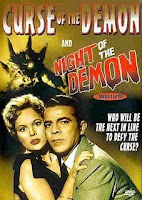“Do you think we might have a psychopath on our hands?” Wearing a distorting plastic mask, a hooded killer is terrorising London Santa's in Britain's answer to the American slasher craze of the 1980s.
WITH a scene of 198 naked, elderly men corralled in an electrified reindeer pen, the release of Finnish horror RARE EXPORTS: A CHRISTMAS TALE is set to rekindle interest in the sleazy sub-genre of mean-spirited Christmas cinema. Origins of this particular type of film can be traced back to the Mexican-made SANTA CLAUS in 1959, which displays both a nauseatingly wholesome attitude to its hero and near surreal art direction. It features Santa battling Satan, who sends bad dreams to innocent children and inspires them to break windows and steal toys. The original killer Santa appeared in the celebrated And All Through the House segment of TALES FROM THE CRYPT, before the festive season was the setting for two influential slashers released in 1974: the sorority-house based BLACK CHRISTMAS and the giallo-like SILENT NIGHT, BLOODY NIGHT. The most notorious, SILENT NIGHT, DEADLY NIGHT is actually nothing special, but came along at the wrong time and felt the brunt of a slasher-weary protest movement during its 1980s explosion. Rather than following the mold of these previous entries, DON'T OPEN TILL CHRISTMAS makes Santa the victim, focusing on the search for a London serial killer who slays Shopping Centre Father Christmas's.
The film is associated with a long list of cult personalities. Producers Stephen Minasian and Dick Randall had previously been involved with FRIDAY THE 13TH and PIECES; Derek Ford, a director and writer of sex films throughout the 1960s and 70s, wrote the screenplay; Alan Birkinshaw, who helmed the notorious KILLER'S MOON - here credited as Al McGoohan - is "assistant director"; and Des Dolan (the guiding light behind the Go Video label) provides the score. Fallen star Edmund Purdom heads the cast as Scotland Yard detective Ian Harris, and set dressing is provided by Caroline Munro cameoing as herself, and sex starlets Pat Astley (as a nude model) and Paula Meadows (as the London Dungeon secretary). In his final film Alan Lake plays journalist Giles, a fittingly seedy role to end a seedy life; a notorious heavy drinker who had punched an extra on the set of THE PLAYBIRDS, he was most famous for being the third husband - and attempted murderer - of Diana Dors, before shooting himself in 1984.
Why has a killer such an apparent and vile disgust for Santa and the festive holiday? The answer is supplied in this obligatory childhood flash-back scene.
This role call of suspect talent could not prevent DON'T OPEN TILL CHRISTMAS suffering one of the most troubled shoots in British cinema history. The film took two years to complete and scenes were reshot and rearranged endlessly, with Birkinshaw, Ford, Purdom and editor Ray Selfe all taking turns in the director's chair. What eventually surfaces looks suitably filthy and is technically inept, but at least the body count is kept consistent and the deaths bloody and inventive; one Father Christmas has his penis cut off with a razor, while another has his face thrust into roasting chestnuts. There are also scenes that exude a sleazy charm: the photographer snapping nudes in his grubby bedsit could have come straight from any British smut-fest of the previous decade, and Munro's glittery performance of an instantly forgettable song (Warrior of Love) concludes with a scream when a Santa with a machete in his face comes up through the stage trapdoor.



































